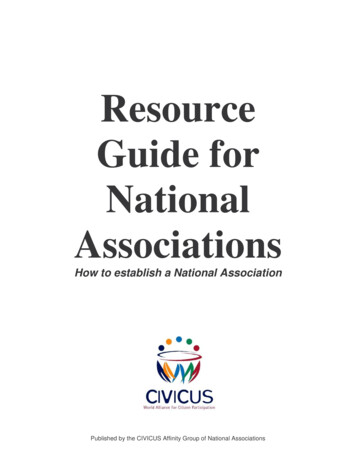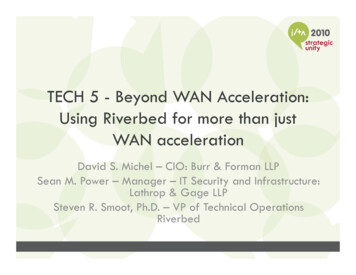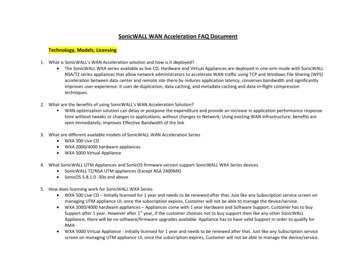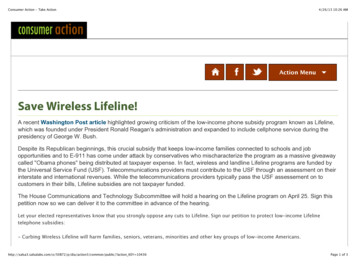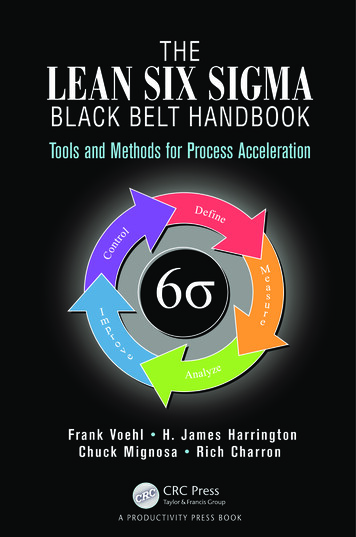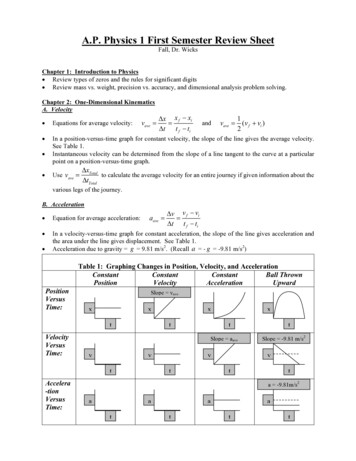
Transcription
Action CoalitionsGLOBAL ACCELERATION PLANEXECUTIVE SUMMARY
TABLE OF CONTENTSEXECUTIVE SUMMARYWe would like to thank the Governments of Franceand Mexico for their leadership as co-hosts of theGeneration Equality Forum, together with thesupport of civil society and youth as well as theAction Coalition Leaders and Commitment Makersfor signaling their support to accelerate progressand catalyze action towards gender equality. UNWomen serves as the Secretariat of the GenerationEquality Forum and Action Coalitions.Substantive Editor: Shannon KowalskiDesign and Illustration: theDifference Consulting4I. ACTION COALITIONS APPROACH10II. ACTION COALITIONS BLUEPRINTS20Gender-Based Violence26Economic Justice and Rights46Bodily Autonomy & Sexual Reproductive Health and Rights64Feminist Action for Climate Justice86Technology & Innovation for Gender Equality104Feminist Movements & Leadership124III. SPOTLIGHT ON FEMINIST MOVEMENTS144IV. SPOTLIGHT ON ADOLESCENT GIRLS RIGHTS146V. SPOTLIGHT ON DATA148VI. ACTION COALITIONS: ACCOUNTABILITY & MONITORING FRAMEWORK152VII. NEXT STEPS156ANNEX 1: ACTION COALITIONS MEASUREMENT FRAMEWORKS160
IT IS TIME TO MOVE FROM RHETORIC TO ACTIONEXECUTIVESUMMARY26 years after the Fourth World Conference on Women in Beijing,too little has changed. There, and in multiple forums since,including in the Sustainable Development Goals, world leadershave pledged to eliminate gender inequalities and realize women’sand girls’ human rights. Yet, public commitments have not beenmet with the action, financing or implementation of laws, policiesand programs needed to meet these goals.At current rates of progress, morethan 2.1 billion women and girls willlive in countries that will not reachany key gender equality targets by2030. And no woman or girl will livein a country that meets all of them.1COVID-19 has made the situation worse. Incountry after country women and girls have beendisproportionately impacted: they make up themajority of frontline health and other essentialworkers and have experienced surges in violence,poverty, and unpaid work. Government responseshave been insufficient: only a small fraction ofsocial protection, labor market and fiscal policiesto address COVID-19 are gender-sensitive.24In this UN Decade for Action on Gender Equality,it is time for change. It is time to move from rhetoricto action. Through the Generation Equality Forum,which kicked off in Mexico and culminated in France,we are building a powerful, global movementfor gender equality that will deliver progress forwomen and girls, in all their diversity.The Generation Equality Action Coalitions take onsix critical issues that underpin gender equality:i) Gender-Based Violence; ii) Economic Justiceand Rights; iii) Bodily Autonomy and Sexual andReproductive Health and Rights (SRHR); iv) FeministAction for Climate Justice; v) Technology andInnovation for Gender Equality; and vi) FeministMovements and Leadership.¹ Equal Measures 2030, 2020. Bending the Curve Towards GenderEquality by 2030. Surrey, United Kingdom: Equal Measures 2030, p. 7.² See UNDP and UN Women. 2020. COVID-19 Global GenderResponse Tracker. https://data.undp.org/gendertracker/. Of3,112 policy measures in response to COVID-19 in 219 countriesand territories, only 1,299 across 187 countries and territoriesare gender sensitive. Most focus on addressing violence againstwomen and girls (832 in 149 countries), whereas measures tostrengthen women’s economic security (287) and address unpaidcare work (180) are much fewer in number.5
640M women have experiencedphysical and sexualviolence at the hands oftheir intimate partner126 YEARS AFTER THE FOURTH WORLD CONFERENCE ON WOMEN,TOO LITTLEHAS CHANGEDCOVID-19 HAS EXACERBATED THE GENDER INEQUALITY CRISIS3Xthe amound of unpaidcare work women docompared to men3women who wantedto avoid pregnancydid not use anycontraceptive method22/319%of girls are marriedbefore the age of 185 1%of global DAC aidfor gender equalitygoes to womenrights organizations76190Mof women are in the workforcecompared to 90% of men, whichremains largely unchanged forthe last 3 decades4135.6estimated years beforewomen will achievepay or leadershipequity with men6¹ World Health Organization, 2021. Violence Against Women Prevalence Estimates 2018. Geneva: World HealthOrganization, p.12.;² UN Women, 2020. Gender equality: Women’s rights in review 25 years after Beijing. New York: UN Women, p. 2.Refers to women of reproductive age.3UN Women, 2019. Progress of the World’s Women: Families in a Changing World. New York: UN Women, p. 146.4World Economic Forum, 2021. Global Gender Gap Report 2021. Geneva: World Economic Forum5UN Women, 2020. Gender equality: Women’s rights in review 25 years after Beijing. New York: UN Women,6World Economic Forum, 2021. Global Gender Gap Report 2021. Geneva: World Economic Forum7OECD DAC Network on Gender Equality, July 2020. “Aid Focused on Gender Equality and Women’s Empowerment:A snapshot of current funding and trends over time in support of the implementation of the Beijing Declarationand Platform for Action.” Paris: Organization for Economic Cooperation and Development.7
WORKING TOGETHERTO DRIVE CHANGEThe Action Coalitions are bringing togethergovernments, women’s, feminist and youthled organizations, international organizations,foundations and businesses to drive change.Through blueprints for action co-created byAction Coalition leaders, they are catalyzingcollective commitments; sparking global and localconversations between generations and acrosscommunities; and driving substantial increases inpublic and private funding.Now, Commitment Makers from all sectors ofsociety, are stepping up to provide resources, leadadvocacy, implement law and policy change, andestablish programmes to help make the blueprintsa reality. Each Action Coalition is also mobilizingcollective commitments: actions that can bringimpact to scale. These include a Global Allianceon Care to expand quality, public care services;an initiative to shape markets and increaseaccess to reproductive health commodities; theestablishment of a Gender-Just Climate SolutionsScale Fund; and a Global Alliance for SustainableFeminist Movements, amongst others.ACTION COALITIONBLUEPRINTSACCOUNTABILITYEach Action Coalition blueprint lays out a powerfulvision for success, as well as priority actions,strategies and tactics to help achieve it. TheAction Coalitions’ work has been informed by acommitment to feminist leadership, transformativechange and putting an intersectional approachinto practice—that is recognizing that many womenand girls experience multiple and intersectingforms of discrimination based on their identities,realities, and unequal access to power andresources and taking meaningful steps to addressit. The blueprints also establish key targets thatwill be used to assess the impact of the ActionCoalitions’ work. Together, the blueprints representa Global Acceleration Plan for gender equality.They will increase the pace of progress towardsthe achievement of the Sustainable DevelopmentGoals and the full implementation of the BeijingPlatform for Action in this UN Decade for Actionon Gender Equality.8COMMITMENTSAccountability is being built in to the process:Commitment Makers will report on their progress;UN Women will monitor progress towardsAction Coalition targets; and together diversestakeholders will measure the collective impact ofthe Action Coalitions on the lives of women andgirls. Action Coalitions will also evaluate the extentto which they are creating and implementingprocesses that contribute to transformativechange, by attending to inequalities in poweramong and between leaders and taking concretesteps to address them.The Action Coalitions can deliverconcrete progress on gender equalityacross generations to come for girlsand women in all of their diversity.But to be successful, diversestakeholders need to come tothe table with COMMITMENTS,RESOURCES and ACTION.WILL YOUJOIN US?9
ACTIONCOALITIONSAPPROACH1011
THE ACTIONCOALITIONSJOURNEYFrom the start, the Action Coalitions and theirblueprints were conceptualized and developedthrough a process of co-creation that broughttogether feminist and youth leaders, and representatives of other civil society organizations,governments, foundations, international organizations, and the private sector.At a design sprint in Mexico City in December2019, diverse leaders weighed a range of issuesthat needed urgent action to advance women’sand girls rights, in all their diversity, and the extentto which they were already being addressedthrough other forums and initiatives. Drawing ontheir advice, the Generation Equality Forum CoreGroup — UN Women, Mexico, France, and the CivilSociety Advisory Group—narrowed in on six ActionCoalition themes and launched a call for leadersfrom all sectors to step forward to develop blueprints to address them.At a second design sprint in Paris in February2020, diverse leaders envisioned how the ActionCoalition themes would accelerate changefor women and girls in all their diversity andrecommended potential areas for action. Theyalso defined the principles that inform the work ofthe Action Coalitions — intersectionality, feministleadership and transformation — and started tosketch out possible models for governance andaccountability moving forward.More than 2000 civil society, international andregional organizations, governments, foundations,and businesses submitted letters of interest tobecome leaders of Action Coalitions. Applicationsfrom feminist, women’s rights, youth-led and othercivil society groups were reviewed through aprocess established by the Youth Task Force andCivil Society Advisory Group, which involved civilsociety representatives from other governancemechanisms established for the GenerationEquality Forum. The process aimed to ensurediverse leadership from civil society and youthled organizations working at various levels fromthe grassroots to global, with different areas ofexpertise, and representing historically marginalizedcommunities, including groups led by LGBTQ people, women and girls with disabilities, andindigenous women and girls, among others. Afinal group of leaders across all sectors and for allAction Coalitions was agreed upon by the CoreGroup, which as of September 2020, also includedrepresentatives from the Youth Task Force.Through a series of workshops, consultationsand dialogues, Action Coalition leaders workedtogether and with their constituencies to developthe blueprints. The draft blueprints were sharedat the Generation Equality Mexico City Forum andthen, taking into account ideas generated there andin other spaces, finalized and formally launched atthe Generation Equality Paris Forum.1213
WHY ARE THE ACTIONCOALITIONS CATALYTIC?Girls, women and gender-diverse people cannot live full, free andequal lives if discriminatory social norms, laws and practices hold themback and stifle their potential. But gender equality is not just good forwomen and girls: it is the foundation for building just and equitablesocieties, where everyone can thrive. It underpins economic and socialsystems that include, and work for, all people and it is essential for thesurvival of the planet.The effort is all the more urgent now. COVID-19 has laid bare criticalgaps in equality that have left millions of women and girls – particularlythose who are most marginalized and who experience discriminationon multiple grounds – behind. COVID-19 has exacerbated the lack ofprogress on gender equality by deepening poverty, increasing ratesof violence, cutting off access to critical social services like school andhealth care, and increasing women’s and girls’ burden of unpaid work.The pandemic is straining health systems, widening socio-economicgaps, and shifting strategic, political, and funding priorities, all of whichdisproportionately and negatively affect women and girls.In this light, the Generation Equality Action Coalitions are an extraordinaryplatform for change, both in their approach and level of ambition. Theybring together diverse stakeholders to address some of the most intractable barriers to equality—from violence, to climate change, and economicsystems that leave women and girls behind.Action Coalitions represent a unique partnership. Their Leaders andCommitment Makers include feminist activists, diverse leaders ofgrassroots, indigenous and community-based organizations, youthleaders, and representatives from private foundations, the private sector, international and regional organizations, and governments, whoare committed to taking collective action for gender equality. Theyhave been working together to build plans that, if implemented andfully funded, will lead to lasting and transformative change and help toensure that women, girls and gender diverse people everywhere canfully enjoy their human rights. And in doing so they are demonstratinghow diverse stakeholders can increase their impact by coming together,actively working to equalize power in decision making, and centeringthe needs of the most marginalized communities in their work.Photo: UN Women/Dzilam Méndez1415
WHAT ARE THE CORE PRINCIPLES OFTHE ACTION COALITIONS?Intersectionality, feminist leadership and transformation are principles that inspire how the ActionCoalitions operate and what they aspire to achieve. All Action Coalition Leaders and CommitmentMakers are encouraged to reflect these principles within their own organizations, governments, institutions, and companies, as well as in their collective work.INTERSECTIONALITYAction Coalitions seek to put an intersectional approach into practice by shedding lighton the multiple and intersecting forms of discrimination that are experienced by manywomen and girls because of their identities, realities, backgrounds, and unequal accessto power and resources, and addressing them. It requires recognizing the uniquechallenges faced by people who experience intersecting forms of discrimination andthe power dynamics and systems that reinforce them, and meaningfully and intentionallyworking to counter them.1WHAT CONCRETEACTIONS ARE BEINGPUT FORWARD?Action Coalition leaders have come together to define atargeted set of actions that are concrete, transformative,measurable and require multi-stakeholder collaboration.The actions have been informed by a rigorous analysis ofthe threats and challenges to women’s and girls’ humanrights, and built on experience and evidence about whatstrategies and tactics are effective in driving change. Theyrecognize the critical role of feminist and other social movements in pushing for accountability on gender equality andhuman rights. And they seek to amplify impact by drawing on the different strengths, roles and responsibilitiesthat Action Coalition Leaders and Commitment-Makersbring to the table. These are reflected in individual andcollective commitments for action.FEMINIST LEADERSHIPFeminist leadership aims to explicitly and intentionally redistribute power andresponsibility in a way that is inclusive, participatory, and mindful of gender, age, race,social class, sexual orientation, ability and other intersecting identities. It involves acontinuous commitment to keep vigilant about – and challenge – the (re)production ofpractices and behaviours that deter collaboration, proactive listening and that benefita few at the expense of others.2TRANSFORMATIONAction Coalitions seek to transform structures, systems and power that reinforceinequalities as an end goal, and in their own ways of working. In so doing, the ActionCoalitions seek to build a collective vision through approaches that value co-creation,dialogue, shared perspective, and centering the voices of historically marginalizedgroups. Youth leadership is critical to the transformative vision of the Generation EqualityAction Coalitions.Crenshaw, K. 1989. “Demarginalizing the Intersection of Race and Sex: A Black Feminist Critique of Antidiscrimination Doctrine, FeministTheory and Antiracist Politics,” University of Chicago Legal Forum: Vol. 1: 139-167. Analysis in this document provided by the Young FeministManifesto, March 2021.2See Young Feminist Europe. 2021. “Young Feminist Manifesto.” Accessed 1 March 2021. -manifesto/ for a full overview and analysis of feminist leadership.116Photo: UN Women/Ryan Brown17
TOGETHER,GENDER-BASED VIOLENCEECONOMIC JUSTICE AND RIGHTSThe following actions drivethis agenda:More states and regional actors ratify internationaland regional conventions and public and privatesector institutions strengthen, implement and financeevidence-driven laws, policies and action plans to endgender-based violence against women and girls in alltheir diversity. In so doing, 550 million more women andgirls will live in countries with laws and policies prohibiting all forms of gender-based violence against womenand girls by 2026.1122CTIONSthe Action Coalition blueprintsrepresent a Global AccelerationPlan for gender equality.18Scale up implementation and financing of evidence-driven prevention strategies by public andprivate sector institutions and women’s rights organizations to drive down prevalence of gender-based violenceagainst women, adolescent girls and young women inall their diversity including in humanitarian settings. Inso doing, increase by 50% the number of countries thatinclude one or more evidence-driven prevention strategies on gender-based violence against women and girlsin national policies by 2026.3Scale up implementation and financing of coordinated survivor-centered, comprehensive, quality,accessible and affordable services for survivors of gender-based violence against women and girls in all theirdiversity including in humanitarian settings. In so doing,more women and girls will live in countries with multi-sectoral action plans on GBV which include provision ofpolice, justice, health and social sector services by 2026.4Enhance support and increase accountability andquality, flexible funding from states, private sector,foundations, and other donors to autonomous girl-led& women’s rights organizations working to end gender-based violence against women and girls in all theirdiversity. In so doing, progressively improve and increaseinternational funding by 50% to women’s rights organizations, activists and movements including those workingto address gender-based violence against women andgirls in all their diversity by 2026.By 2026, increase the number of countries with acomprehensive set of measures in gender-responsivepublic and private quality care services, and law and policyreforms, including through investments of recommended3-10% of national income and creation of up to 80 million decent care jobs to recognize, reduce and redistributeunpaid care work and reward paid work and represent careworkers, while guaranteeing care worker’s decent pay andlabor rights, including in the private sectorCreate an inclusive and enabling legal and policyenvironment and engage women to expand decentwork in the formal and informal economy to reduce thenumber of working women living in poverty by 2026 by arecommended 17 million and decrease the gap in labourforce participation between prime-age women and menwith small children by half, resulting in an additional 84million women joining the labour force.3Expand women’s access to and control over productive resources through increasing women’s accessto and control over land, gender responsive financialproducts and services, and the number of firms owned bywomen by 2026. In doing so, Secure access to ownership and control over landand housing is increased for 7 million women; The gender gap in women’s financial inclusionis reduced to 6% by increasing both formal andinformal financial inclusion, including for women atrisk of being excluded from formal financial services; The number of women’s economic empowermentnational programs integrating digital financialservices and participation through gender-responsiveplatforms is increased; The number of firms owned by women is increasedby 25% in all contexts, including in fragile andconflict situations.BODILY AUTONOMY &SEXUAL AND REPRODUCTIVEHEALTH AND RIGHTS1Increase delivery of comprehensive sexualityeducation in and out of school reaching 50 millionmore children, adolescents, and youth in all their diversityby 2026.2Within a comprehensive framework that includesSRHR services as an essential component of UHCfor all people, increase the quality of and access to contraceptive services for 50 million more adolescent girlsand women in all their diversity; support removal ofrestrictive policies and legal barriers, ensuring 50 millionmore adolescent girls and women in all their diversitylive in jurisdictions where they can access safe and legalabortion by 2026.3Through gender norms change and increasingknowledge of rights, empower all people including260 million more girls, adolescents and women in all oftheir diversity to make autonomous decisions about theirbodies, sexuality and reproduction by 2026; enact legaland policy change to protect and promote bodily autonomy and SRHR in at least 20 countries by 2026.4Increase accountability to, participation of andsupport for autonomous feminist and women’sorganizations (including girl and adolescent-led, andIndigenous organizations and collectives), women humanrights defenders and peacebuilders. Strengthen organizations, networks and movements working to promoteand protect bodily autonomy and SRHR.4Design and implement gender-responsive macroeconomic plans, budget reforms and stimuluspackages so that the number of women and girls living inpoverty is reduced by 85 million including through qualitypublic social protection floors and systems by 2026.19
FEMINIST ACTION FORCLIMATE JUSTICETECHNOLOGY & INNOVATIONFOR GENDER EQUALITYFEMINIST MOVEMENTS& LEADERSHIP111By 2026, increase the percentage of global climatefinance flows, public and private, directed towardsand invested in gender-just climate solutions in particular at grassroots and rural levels, including through anincrease to 88% in the proportion of marked climate bilateral finance targeted towards gender.2Increase the proportion of women and girls in decision-making and leadership positions throughoutenvironmental governance and sectors relevant for transitioning to an inclusive, circular and regenerative greeneconomy by 2026.3Enhance and leverage the capacity of millionsmore women and girls in all their diversity to buildresilience to climate and disaster risks, mitigate climatechange, and address loss and damage, including throughthe provision of quality education, community-basedcooperative models and land rights and tenure security.4By 2026, at least 20 countries demonstrate increaseduse of gender-environment statistics for policy making by creating an enabling environment for and increasedproduction of gender-environment statistics.By 2026, reduce by half the gender digital divideacross generations by accelerating meaningfulaccess to digital technologies and universal digital literacy.2By 2026, increase investments towards feministtechnology and innovation by 50% to supportwomen’s leadership as innovators and better respond towomen and girls’ most pressing needs.3By 2026, double the proportion of women workingin technology and innovation by setting up new networks and benchmarks to transform innovation ecosystems.4By 2026, a majority of countries and tech companiesdemonstrate accountability by implementing policies and solutions against online and tech facilitated GBVand discrimination.By 2026, double the global annual growth rateof funding from all sectors committed to womenled, girl-led and feminist-led movements, organizations,and funds in all their diversity, including those led byhistorically marginalized women and people, includingtrans, intersex and non-binary people.2Promote, expand, strengthen, and protect civic spaceacross all domains, including online, and support theefforts of feminist activists in all their diversity, includingwomen’s human rights defenders, women peacebuilders,trans, intersex and non-binary people, girls and othermembers of historically marginalized groups, to defendcivic space and eliminate barriers to feminist action,organizing and mobilization in all its diversity.3By 2026, advance substantive representation andincrease the meaningful participation, leadershipand decision-making power of girls and youth leaders,and of women, and feminist leaders in all their diversity,including those who are trans, intersex and non-binary,through efforts to: (1) Advance gender parity and theinclusion of those historically marginalized in all aspects,sectors and levels of public and economic decisionmaking, including the private sector, civil society,international organizations, political and governmentinstitutions and executive and legislative positions (2)Promote and expand feminist, gender transformative,intersectional approaches to decision-making andleadership, which acknowledge, analyse and challengeexisting power relations and advance inclusive, gendertransformative and rights-affirming laws and policies.4By 2026, allocate, monitor and evaluate specific,flexible financial, technical, and other resources foradolescent girls and young feminist leaders and theirmovements and organizations to strengthen them, andcreate safe and inclusive spaces to lead, share ownershipand substantively participate in and co-create decisionmaking processes.2021
WHAT COMESNEXT FORTHE ACTIONCOALITIONS?Action Coalition leaders and CommitmentMakers will now work together to implementthe blueprints through the delivery of specificresources, advocacy, legal and policy change,and programmes. Commitment Makers will joina dynamic community of practice, and sharesuccesses, challenges and lessons learned; takestock of progress; and identify areas where additional collective action and investment is neededto drive change.Together, Action Coalitions will work to ensureaccountability—for both progress against individual commitments and the collective impact ofits work on the lives of women, girls and genderdiverse people.THIS IS THE START OF A PROCESSOF TRANSFORMATIVE CHANGE.Photo: UN Women/Carlos Rivera2223
THE GENERATION EQUALITY ACTION COALITIONS ARE THE WORLD'S ROADMAP TO ACCELERATE GENDER EQUALITYGENDER-BASEDVIOLENCEECONOMIC JUSTICEAND RIGHTSBODILY AUTONOMYAND SRHRFEMINIST ACTION FORCLIMATE JUSTICETECHNOLOGY AND INNOVATIONFOR GENDER EQUALITYFEMINIST MOVEMENTSAND LEADERSHIP
Mar 01, 2021 · Each Action Coalition blueprint lays out a powerful vision for success, as well as priority actions, strategies and tactics to help achieve it. The Action Coalitions’ work has been informed by a commitment to feminist leadership, transformative change and putting an intersectional a
